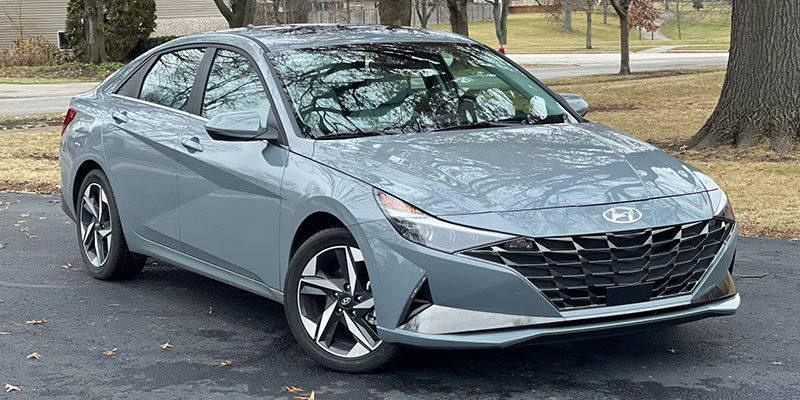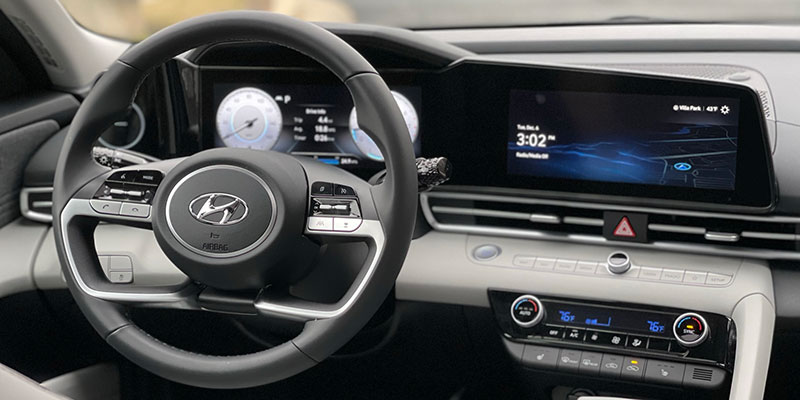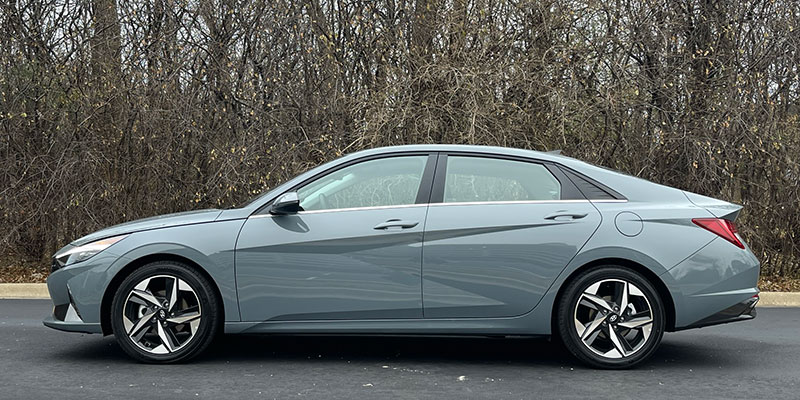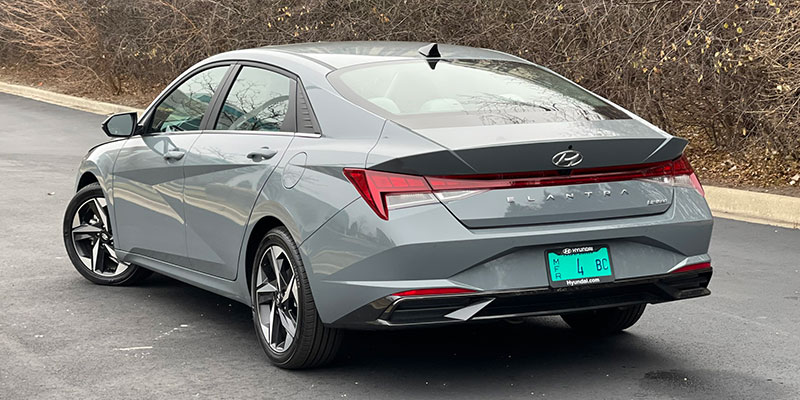Affordable and reliable are no longer the only words to describe Hyundai's compact Elantra.The latest version of the Elantra adds new styling elements, technology, and performance. The Elantra first appeared over 30 years ago when it debuted in 1990 and is currently in its seventh generation. It was completely re-done for 2021 with a longer, wider body and new styling in and out. The Elantra continues to be offered as a 5-passenger, 4-door, front wheel drive compact sedan.

For 2023, there are four trim levels known as the SE, SEL, Limited, and N Line. Also available is a performance-oriented Elantra N that has its own 2.0L turbo GDI 4-cylinder delivering 276 horsepower and 289 pound-feet of torque with a manual transmission.
The rest of the line up is available in three different powertrains. SE, SEL, and Limited all come with a 2.0L DOHC inline 4-cylinder that pumps out 147 horsepower. The N Line gets a 1.6L turbo GDI DOHC inline 4-cylinder that delivers 201 horsepower. And the Blue / Limited hybrid models utilize a 1.6L GDI inline 4-cylinder that pairs with an electric motor to generate a combined 139 horsepower. Prices range from $20,650 to $32,900. Competition includes sedans such as the Honda Civic, Kia Forte, Mazda 3, Nissan Sentra, Toyota Corolla, Subaru Impreza, and Volkswagen Jetta. I spent a week in the Elantra Limited, and here's what stood out...
Styling (+/-)Hyundai went bold and dramatic with the new Elantra. It's a blend of smooth and sharp edges... from some angles I really like it while others are questionable. Up front is a dominant front grille that we see across the lineup on siblings such as the Sonata, Tucson and Santa Cruz. The rounded front is a stark contrast to the angular rear end of the car which has a very sharp angle inwards from the trunk line that is accented by the LED lighting strip across the trunk. Under that light bar is Elantra centered and spelled out across the trunk. The side profile is where I struggle as the overhangs seem extra-long and when combined with the geometric character lines, it may just be too much. I wish the wheelbase was stretched a couple more inches to give the car a better stance from all angles. Nonetheless, I do think it's quite sporty and they've added some good-looking 17" and 18" wheel options.

Interior (+/-)
Hopping inside, the Elantra has adopted the extra-large extended digital screen look with a 10.25" digital instrument cluster blending into the adjacent 10.25" infotainment touchscreen which is currently the largest screen in the class. The all-digital screens give the Elantra a very modern look that ties into technology such as the wireless Apple CarPlay and wireless Android Auto. Below the screen is a row of buttons that includes the push button ignition, volume control and quick navigation buttons for the digital screen. Further down in the dash are traditional buttons for climate control and traditional gear shifter. Hyundai has also added an angular trim piece that stretches down from the dash to give a more driver-centric look to the layout.
While the available options are plentiful, some of the materials are lackluster on a closer inspection. Hard plastics and cheaper cloth materials on the seats remind you that it's still an economy car despite a modern tech-oriented layout. Competitors such as the Mazda 3 offer much more premium materials, but with that also comes a higher price.
Technology (+)Elantra technology was user-friendly and well placed. The digital cluster was easily visible with crisp high-definition graphics and large screens. The digital display changed with each drive mode selection. One oddity though is that the aforementioned wireless Apple CarPlay & Android Auto are not available on high trim models equipped with the larger screens.Those models will require a cord to utilize the integration. Other interior options that stand out are an 8-speaker Bose premium audio system, ambient lighting, and a sunroof.
Seating (+/-)Cloth upholstery and manually adjustable seats are standard, although power and leather are optional. The cloth material felt subpar in a car that was otherwise very well equipped. Materials aside, I found the seats to be comfortable and sightlines were all good. Personally, it would be worth optioning up to the available leather seats that come standard on the Limited model with a $26,350 list price. The materials found in the Limited feel a step up and make the Elantra feel like an even better value. Overall cabin space was good with plenty of head and leg room for five passengers. Rear seats feature two full sets of LATCH connectors for car seats, although they are deep within the seats.
Cargo (+)Cargo volume is good with 14.2 cubic feet of trunk space which carries over from the previous generation. This is the advantage of the large rear overhang that visually is less appealing. Despite the large space, the opening to access the area is smaller due to the design of the rear of the car. The smaller opening will make it more challenging with items such as strollers compared to competitors such as the VW Jetta with a large trunk and opening or the others in the segment that also offer a hatchback option (Civic, Corolla, and Mazda 3).

Performance (+)Both turbo engines will pair to either a 6-speed manual or a 7-speed automatic. My test model came with the base engine which was sufficient for suburban commuting and offered good fuel economy. The CVT was responsive and the gears shift smoothly at highway speeds. Road noise was minimal and there was no whine from the engine when pushed which used to be the case in compact sedans.
Elantra offers drivers a well-rounded performance that won't excite nor disappoint you... it treads comfortably in the middle of the pack. Handling was stable enough in the Limited, but reviews of the N Line and N suggest they offer a more dynamic driving experience. Playing it safe under the hood of its volume leaders makes sense since it keeps the overall price point and fuel economy down which are two key factors in this segment.
Fuel Economy (+)
Fuel economy is rated at 35 MPG combined, 31 city and 41 highway. When it arrived with a full 14-gallon tank, it offered 460 miles of range. After a week of driving, I averaged 33.1 MPG. These numbers are above average for the class. Opt for hybrid models and get 54 MPG combined, 53 city, 56 highway.
Safety (+)Like many other Hyundais, the Elantra comes with a list of standard safety features that include forward collision-avoidance assist with pedestrian detection, blind-spot collision-avoidance with rear cross-traffic assist, safe exit warning, rear occupant alert, lane keeping assist, lane following assist, high beam assist and driver attention warning. Additional available safety features include forward collision-avoidance assist with pedestrian detection, smart cruise control with stop & go, highway driving assist, parking distance warning-reverse and parking collision-avoidance.

Final StatementThe Elantra carries over for 2023 after its recent overhaul. It comes with a very reasonable starting price that includes a lot of standard features. Hyundai has given it technology and driver assistance features that will cost a premium in luxury brands, but are standard on the Elantra. Overall, this is a great option with a good reputation behind it for someone looking for a stylish, no-nonsense sedan.
First Impression Summary
Test Vehicle: 2023 Hyundai Elantra Limited
Exterior Color: Electric Shadow
Interior Color: Gray Melange
Notable Options: None
Price as tested: $27,655 (with destination charge)